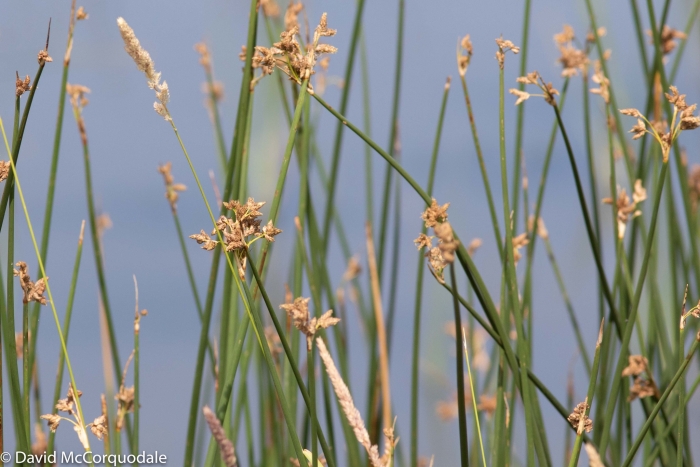Hardstem Bulrush
(Schoenoplectus acutus)
Hardstem Bulrush (Schoenoplectus acutus)
/
/

David McCorquodale
CC BY 4.0
Image By:
David McCorquodale
Recorded By:
Copyright:
CC BY 4.0
Copyright Notice:
Photo by: David McCorquodale | License Type: CC BY 4.0 | License URL: http://creativecommons.org/licenses/by/4.0/ | Rights Holder: David McCorquodale | Publisher: iNaturalist | Date Created: 2019-07-16T10:37:08-07:00 |
















































Estimated Native Range
Summary
Schoenoplectus acutus, commonly known as Hardstem Bulrush, is a deciduous perennial grass native to wetlands such as marshes, lake edges, and riverbanks across the USA as well as Southern Canada. It can reach heights of 1 to 3 meters (3 to 10 feet) and is characterized by its thick, round, green stems and long, grass-like leaves. The flowers are radially symmetrical, clustered, and pale brownish, typically appearing in the summer months. Hardstem Bulrush is crucial for wetland ecology, providing habitat for wildlife and stabilizing shorelines to prevent erosion.
Hardstem Bulrush is valued for its ecological role and is often used in wetland restoration and bioengineering projects due to its extensive rhizome system. It thrives in full sun and requires high amounts of water, making it suitable for riparian plantings. It is adaptable to a range of soil drainage conditions, from slow to fast. While it is not typically used for ornamental purposes, it can be an effective plant for naturalizing areas or creating wildlife habitats. Care should be taken as it can become invasive in some regions outside its native range, potentially outcompeting local flora.CC BY-SA 4.0
Hardstem Bulrush is valued for its ecological role and is often used in wetland restoration and bioengineering projects due to its extensive rhizome system. It thrives in full sun and requires high amounts of water, making it suitable for riparian plantings. It is adaptable to a range of soil drainage conditions, from slow to fast. While it is not typically used for ornamental purposes, it can be an effective plant for naturalizing areas or creating wildlife habitats. Care should be taken as it can become invasive in some regions outside its native range, potentially outcompeting local flora.CC BY-SA 4.0
Plant Description
- Plant Type: Grass
- Height: 3-9 feet
- Width: 1-3 feet
- Growth Rate: Moderate
- Flower Color: N/A
- Flowering Season: Spring, Summer
- Leaf Retention: Deciduous
Growth Requirements
- Sun: Full Sun
- Water: High
- Drainage: Slow, Medium, Fast
Common Uses
Bird Garden, Deer Resistant, Erosion Control, Low Maintenance, Water Garden
Natural Habitat
native to wetlands such as marshes, lake edges, and riverbanks across the USA as well as Southern Canada
Other Names
Common Names: Common Tule, Hard-Stemmed Bulrush, Tule Rush, Viscid Bulrush, Scirpe Aigu, Schoenoplectus
Scientific Names: , Schoenoplectus acutus, Schoenoplectus lacustris subsp. acutus, Scirpus lacustris subsp. acutus,
GBIF Accepted Name: Schoenoplectus acutus (Muhl. ex Bigelow) Á.Löve & D.Löve